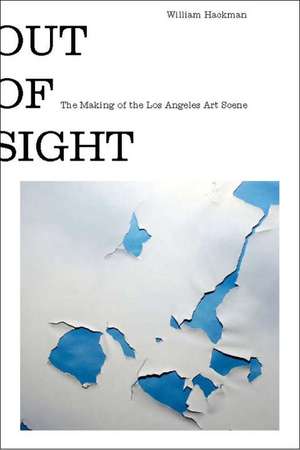Out of Sight: The Los Angeles Art Scene of the Sixties
Autor William Hackmanen Limba Engleză Hardback – 13 apr 2015
Out of Sight chronicles the rapid-fire rise, fall, and rebirth of the L.A. art scene—from the emergence of a small bohemian community in the 1950s to the founding of the Museum of Contemporary Art in 1980— and explains how artists such as Ed Ruscha, Robert Irwin, and Ken Price reshaped contemporary art. William Hackman also explores the ways in which the L.A. art scene reflected the hopes and fears of postwar America—both the self-confidence of an increasingly affluent middle class, and the anxiety produced by violent upheavals at home and abroad. Perhaps most of all, he pays tribute to the city that gave birth to a fascinating and until now overlooked moment in modern art.
Preț: 159.40 lei
Nou
Puncte Express: 239
Preț estimativ în valută:
30.50€ • 31.65$ • 25.50£
30.50€ • 31.65$ • 25.50£
Carte indisponibilă temporar
Doresc să fiu notificat când acest titlu va fi disponibil:
Se trimite...
Preluare comenzi: 021 569.72.76
Specificații
ISBN-13: 9781590514115
ISBN-10: 1590514114
Pagini: 320
Dimensiuni: 160 x 229 x 30 mm
Greutate: 0.59 kg
Editura: Other Press (NY)
ISBN-10: 1590514114
Pagini: 320
Dimensiuni: 160 x 229 x 30 mm
Greutate: 0.59 kg
Editura: Other Press (NY)
Notă biografică
William Hackman, longtime arts journalist and former managing editor for public affairs at the J. Paul Getty Trust, has written extensively about the visual and performing arts. His essays, articles, and reviews have appeared in major American newspapers and magazines, including the Chicago Tribune, the Philadelphia Inquirer, and the Los Angeles Times. His books include Los Angeles County Museum of Art, for the Art Spaces series (Scala, 2008), and Inside the Getty (J. Paul Getty Trust, 2008). He lives in Los Angeles.
Extras
By the time he was eighteen, Ed Ruscha was sure of two things: he wanted to be an artist, and he needed to get out of Oklahoma. Art school was the answer, and Ruscha knew that the most highly touted ones were in New York, maybe Chicago. But “the East,” he figured—“that’s just too old-world for me.” California was more like it; he had visited with his family as a kid and was taken with what he thought of as “that California style.” Los Angeles was “the only place” to be, as far as Ruscha was concerned. So in the summer of 1956, he packed up his six-year-old Ford with Smitty mufflers and set out on Route 66, heading west.
In the mid-fifties, painters in Los Angeles, like their counterparts in New York, were searching for a way forward in the wake of abstract expressionism. Initially, few artists in either city doubted that the future of painting lay in abstraction of some kind, a presumption that would be seriously challenged only as the decade drew toward its close. Jasper Johns’s paintings of targets and flags were shocking in their use of familiar symbols as “ready-made” images that both were and were not representational. (What, after all, is the difference between a flag and its image?) Ruscha himself would experience the shock firsthand in 1957, when he spied a reproduction of Johns’s Target with Four Faces in a magazine, a work that he said “hit me right between the eyes.”
But the present state of American painting was far from Ruscha’s thoughts as he and his friend and fellow traveler Mason Williams burned through countless quarts of oil, rumbling past the Indian reservations and trading posts, abandoned mining towns, and cheap motels that punctuated their crossing of the scorched desert regions that lay between Oklahoma and Los Angeles.
In the mid-fifties, painters in Los Angeles, like their counterparts in New York, were searching for a way forward in the wake of abstract expressionism. Initially, few artists in either city doubted that the future of painting lay in abstraction of some kind, a presumption that would be seriously challenged only as the decade drew toward its close. Jasper Johns’s paintings of targets and flags were shocking in their use of familiar symbols as “ready-made” images that both were and were not representational. (What, after all, is the difference between a flag and its image?) Ruscha himself would experience the shock firsthand in 1957, when he spied a reproduction of Johns’s Target with Four Faces in a magazine, a work that he said “hit me right between the eyes.”
But the present state of American painting was far from Ruscha’s thoughts as he and his friend and fellow traveler Mason Williams burned through countless quarts of oil, rumbling past the Indian reservations and trading posts, abandoned mining towns, and cheap motels that punctuated their crossing of the scorched desert regions that lay between Oklahoma and Los Angeles.
